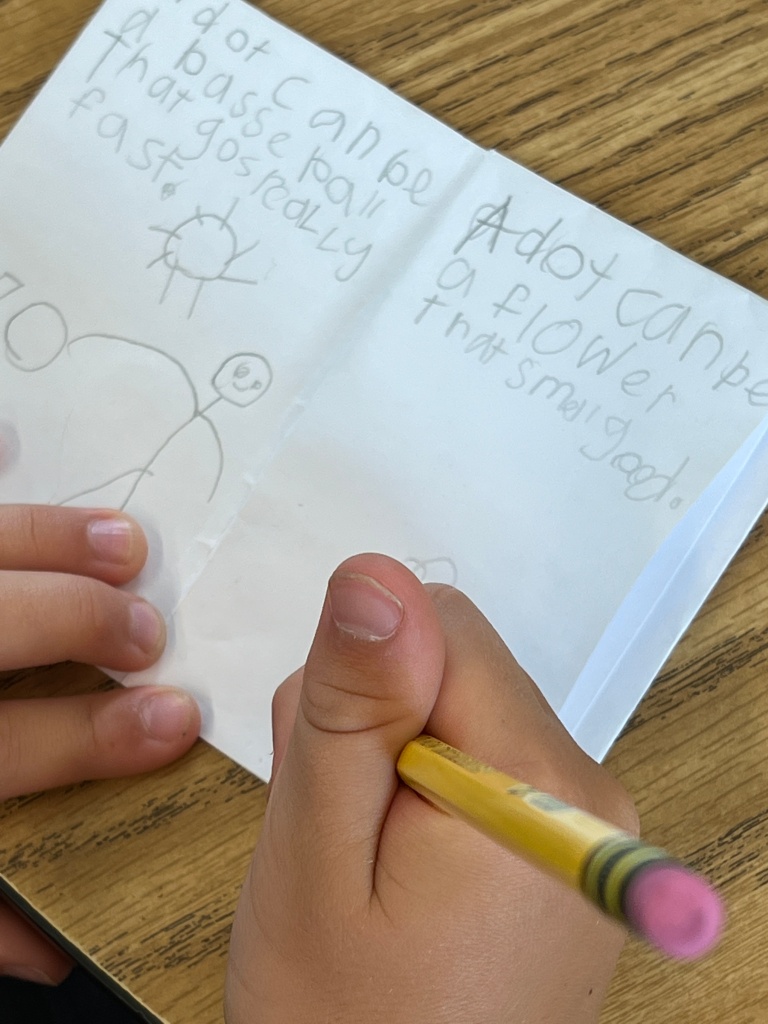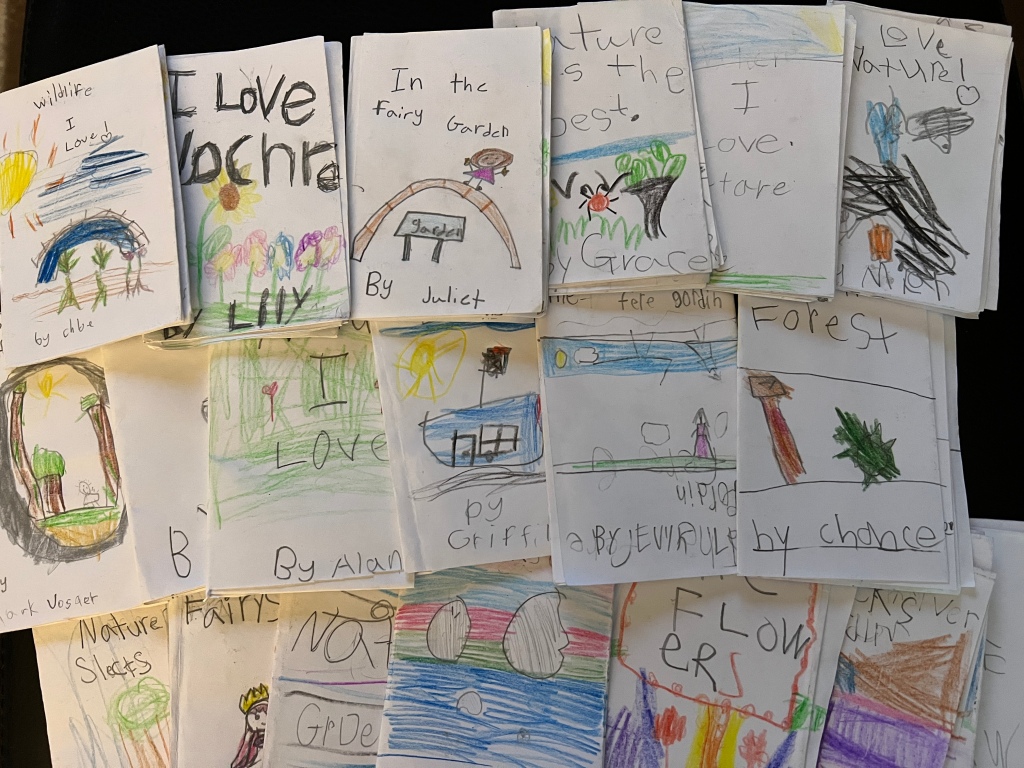
Tag Archives: #writeout
Let’s Write: Celebrating the National Day on Writing
It’s October 20th…and that means it’s the National Day on Writing! We started our day by talking about the reasons we write during our morning meeting. It warms my heart that most of my students mentioned either that writing is fun or one of our recent writing activities (writing letters or making zines) as their reasons for writing. I do feel like we are building a wonderful writing community in our first grade classroom. It’s a place to take risks, a place to express ourselves, and a place to build our knowledge and skills related to writing.
So after recess today, I read my students Kiyoshi’s Walk by Mark Karlin. In this lovely story, Kiyoshi is asking his grandpa where poems come from. On each stop along the walk, Eto (Kiyoshi’s grandpa) writes a short three-line poem about something they see, hear, imagine, or feel…each adding to Kiyoshi’s understanding of where poems come from. At the end, Kiyoshi asks his grandfather if he can write a poem…and writes a beautiful three-line composition for his grandfather. While technically the poems in this book are Haiku, I talked about them as three-line poems rather than engage in syllable counts for my students today.
With this as inspiration, we grabbed our sketchbooks and headed out on our own walk, ending up in our school garden where we wrote our own three-line poems inspired by our walk and our time writing in the garden.


These first graders wrote as many three-lines poems as they could during the time we were in the garden. They wrote about the fog that wafted across the playground, the rollie pollies that they love to rescue from the sidewalks, ladybugs, passion fruit, the sky, tomatoes, potatoes, and so much more.
When we returned to the classroom, writers shared a few of their compositions and then picked their favorite to copy onto another sheet of paper and illustrate. While their poems are still developing, they are beginning to get the idea that there are many different reasons and inspirations for writing. Here are a couple:
I See a Butterfly by C
A butterfly flying
In the garden with yellow wings
Pollinating the garden flowers.
The Blowing Fog by M
The fog is blowing
The rollie pollies are crawling
The flowers are blooming.
I also know that being outdoors is a powerful motivation for writing for the first graders I teach. Changing our writing venue, writing in a sketchbook rather than a notebook, and writing under the influence of nature all keep writing fresh and novel. And my writing with them also matters. I hope they are learning that writing is not just for school, but that it is a lifetime pursuit that can serve many different purposes.
And I know that I don’t need #writeout or the National Day on Writing to keep writing at the forefront of the classroom–but it’s fun to know that there are educators all over taking their students outdoors, playfully approaching writing tasks, and making writing something students love…for so many different reasons.
So I leave this post with the NDOW question, Why do you write?
Time to #WriteOut!
I love October. The weather is warm–it’s still shorts weather. Many of the tourists have gone home, leaving the beaches and the freeways to the locals. My first graders are starting to believe they are writers–and it’s time for #WriteOut! #WriteOut is a partnership between the National Writing Project and the National Park service–a two week effort to encourage everyone to get outside, explore the nature around you, and write.
Last week we warmed up for #WriteOut by going for a Wonder Walk on our school campus. We started by reading the book Wonder Walkers by Micha Archer. This is a wonderful book full of questions like, “Is the wind the world breathing?” that also pushed my students to think beyond the literal, framing their observations through the lens of wonder. After reading and talking, students took their nature collectors (a piece of cardboard with rubber bands around it) and headed out to our pollinator garden to look and wonder and pick up some bits of nature to bring back into the classroom with us.




Later students had to pick just one item from their collection to examine much more closely. To facilitate that close observation, we pulled out our sketchbooks and started drawing, trying hard to capture all the details they could see in front of them. Using colored pencils to hone in on subtleties, they added dimension to their sketches. Then using nature notebooking prompts adapted from the work of John Muir Laws including labeling their sketch, adding what does it remind you of and what do you wonder about it, students completed their entry.
The results were stunning. And a perfect beginning to #WriteOut!



The Magic of Mini-Zines
There’s something so special about making things. You use your own hands and something that was once a flat blank piece of paper is suddenly something else, something you created.
We’ve been making Zines in my first grade classroom. Our first attempt happened during our Dot Day celebration. We took a piece of printer paper, folded until we had 8 even rectangles, made a single cut…and voila! The paper became a small, multi-paged book. Those first books became our “A Dot Can Be…” zines.

Last week in honor of #writeout, we spent some time in our pollinator garden and basin area of the playground exploring nature’s artifacts. I wrote about our experience with our nature collectors and our wonder walk here. When I left off with that post students were in the process of creating zines about the nature items they collected. What I love most about these mini zines is the agency students feel about creating them. I also like that it allows students to both “write small” and to be literary in their approach. Students who are emerging as writers might create a page that reads, “Spiders Find a Way” with a beautiful drawing of a spider on a web, while more advanced writers can write, “A rock finds a way to scrub against the tree with happiness.” The writing and creating is accessible to everyone in our first grade class. And the zines are truly tiny jewels!

And after a conversation with some colleagues on the Connecting the Network Call with the National Writing Project last week, I took their suggestion and sent blank zines (made by my students) home with students with an invitation to explore on their own at home and to make a zine on their own. (We forgot to take them home on Friday, so they went home on Monday).
And…just like my colleagues suspected, my students were motivated to write at home. Today this lovely book came in:

My student was excited to read it to me…and for me to read it to the class! It was a delightful nature-based fictional story that involved a bug and a centipede. I’m guessing some more student-created zines may show up in the classroom later this week!
I know we’ll keep on making and writing…and making writing, both inside and outside the classroom. I’m excited about the writing community that my classroom is becoming.
#writeout: Because of an Acorn
When life gives you acorns…turn it into a #writeout inspiration!
On Saturday I found myself at UC Davis meeting with an incredible group of writing project teachers from all over the state as we launched year 2 of our CWP Environmental Literacy and Justice Collaborative. In that space we imagined all the ways to support our students as they learn about the earth and its systems, grow their appreciation of the natural world and resources we share, and use writing to think, to reflect, to question, and to advocate for the world we need and want for ourselves and for our future.
My colleague Carol brought some wonderful acorns she found in her neighborhood as inspiration for a making project…and lucky me, I ended up taking the extras home with me to use in my classroom. These acorns are bigger than the ones I am familiar with…and so beautiful!

And they were perfect for the book I had already borrowed from the library to read this week–Because of an Acorn by Lola Schaefer. After reading and studying this deceptively simple text, we talked about what they noticed in the book. They were quick to notice that it included aspects of life cycles…and they loved the cutouts on the first and last pages. Serendipitously the NWP Write Out newsletter included a link to a video about acorns by a park ranger at the Sequoia and Kings Canyon National Park. My students loved learning more about acorns–and the ways that trees communicate with each other.
Then it was time to pull out our #writeout pencils and notebooks. We took time to look carefully at the acorns and sketch them in detail. Students were encouraged to use numbers and words in addition to their sketch to capture information about their acorn.






After a break for their music class and recess, we returned to our notebooks for some writing. To push students’ thinking, we used the prompts: I noticed…, I wonder…, and It reminds me of to describe the acorn we had studied and sketched. These first graders had no hesitation. They had plenty to write about and were eager to get started! To keep the words flowing, students were encouraged to use their best “kid writing” (or phonetic spelling), prioritizing ideas over correctness.






Best of all, my students are paying attention to the environment and appreciating all that it has to offer. It is my goal that this immersion in nature will lead us toward advocacy as we consider the ways all of us, as community members–young and old(er), can be a catalyst for change to make the world a better place.
Poet-Tree: NPM20 Day 21
My daily walk to the mailbox is generally uneventful. I follow the sidewalk down the hill, past the five or six houses that look similar to my own. I notice the groomed lawns, the xeriscaped designs where lawns once grew, those miniature citrus trees. And today, I noticed the tall thin palm dancing in the breeze.

Inspired by the National Writing Project post, Writing In with #WriteOut, I wrote a Poet-Tree #smallpoem today.
Tree Dance
Against the azure sky
the lone palm dances
solo
slowly swaying
graceful fronds stretched wide
brushing the clouds
to the shush
of spring’s song
®Douillard
Reflections on Writing: #whyiwrite
Each year on October 20th people from all over are invited to write, to share their writing, and to consider the prompt: #whyiwrite. I appreciate a National Day on Writing, a day to celebrate this often unexamined practice that most of us engage in daily. Sometimes we are confused by the word writing, considering only the writing that appears in bookstores, in magazines, or in prestigious online spaces as “real” writing.
Whatever writing we do is real. But fear can keep us from getting those words out of our heads and onto a page. I often find myself writing as I walk, starting a narrative or poem in my head, sparked by something I noticed, overheard, observed. These words are easily lost, blown into the sea breeze if I don’t make a conscious effort to remember long enough to get them written or somehow recorded for later writing and elaboration.
I find that my words take flight when I turn off that internal censor. When I stop worrying about writing the perfect essay, saying the “just right” thing that will dazzle and impress someone else.

But why do I write? I started blogging to hold myself accountable to regular writing. But all I write isn’t reflected in this public space. This space, though, offers me the opportunity to connect, to reflect on my writing, teaching, photography, and life in general. It lets me start small as I wonder and wander through the ideas in my mind.

A writing project meeting yesterday led us to a new room on campus, where this quote was prominent on the walls. I don’t know that it is perfectly true for me, but I like the sentiment. That risk-taking matters. Sometimes we have to approach an old problem in a new way to figure out a solution. I’ve been thinking about that a lot when it comes to teaching. There’s so much talk about how kids are different these days, how they struggle to pay attention (often blamed on our screen-centered society), and how we need to prepare them for jobs that don’t yet exist. Most of these comments are posed as problems, difficulties to overcome instead of aspirations to reach for. Why would we teach students today the same content in the same ways as we taught that class ten years ago? Why is curriculum more similar to than different from what it was when I was a child oh-so-many year ago? Is this student problem really a teaching problem (or a structures around teaching problem)? It might just be an assessment problem, since the content that is tested is certainly prioritized in our schools!

That ever-moving target can sometimes make us all feel like failures. We keep reaching for THE solution, instead of enjoying each wave as we ride it. Watching surfers from the San Clemente pier yesterday reminds me of the importance of patience, playfulness, and persistence. (And those same traits might just apply to the photographer as well!) I’m sure each surfer out there in the cool, salty water in the slant of light on a late fall afternoon was in search of the perfect wave, the great ride, the most fun… What I loved as I watched was noticing the surfers spot potential waves, start and stop–sometimes bailing out of a waves at the last possible moment; lining themselves up to catch the upcoming wave–paddling, turning, jockeying with other surfers for position; playing with waves that turned out to be less than–swan-diving backwards out of the ride. I’m reminded that there is learning and joy in the process, not just the end product. How do we help students (and teachers and parents and the public) see the learning that happens in the trying rather than in the exam or “final product?”

So why do I write? I write to play with words and ideas. I write to problem-solve, to follow a line of thinking to a place where I can grapple with it. I write to pay attention to the world around me, to inhale the joy and exhale the heaviness. And I persist in writing even when it feels too hard, too time consuming, too frustrating, too messy. Writing matters, each one of us has to find all the reasons why for ourselves (we just may need a little nudge from our friends, teachers, lovers, mentors). Thanks for the nudge National Day on Writing!
Now it’s your turn, why do you write?

